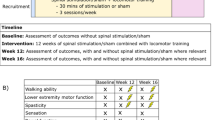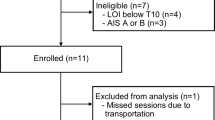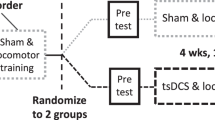Abstract
Study design:
Single case study.
Objectives:
Intensive locomotor training programmes have recently been implemented in paediatric settings for patients with chronic incomplete spinal cord injury. This case study examines whether a lower-intensity locomotor training programme can improve functional ambulation.
Setting:
Tertiary care setting in Melbourne, Australia.
Methods:
A pretest–post-test design was used for a 17-year-old boy, 16 months after incomplete spinal injury at T6, who was classified as American Spinal Injury Association (ASIA) level C. He participated in two weekly sessions of locomotor training for a period of 6 weeks. Lower Extremity Motor Score (LEMS), Walking Index for Spinal Cord Injury (WISCI II), 6-min walk test (6MWT), 10-m walk test (10MWT), Timed Up and Go (TUG), and the PedsQL were measured before training, immediately after training and 6 weeks after training had ceased.
Results:
The WISCI II score improved from 6 at baseline to 9 immediately post treatment and this was maintained at follow-up. The PedsQL score was also significantly improved immediately post treatment and at 6 weeks follow-up. The LEMS and 6MWT improved after the intervention also.
Conclusion:
This case study provides evidence of improvements following a less-intensive locomotor training programme in an outpatient setting. Studies with larger samples are required to fully examine the benefits of this programme.
Similar content being viewed by others
Log in or create a free account to read this content
Gain free access to this article, as well as selected content from this journal and more on nature.com
or
References
Behrman AL, Bowden MG, Nair PM . Neuroplasticity after spinal cord injury and training: an emerging paradigm shift in rehabilitation and walking recovery. Phys Ther 2006; 86: 1406–1425.
Edgerton VR, Tillakaratne NJK, Bigbee AJ, de Leon RD, Roy RR . Plasticity of the spinal neural circuitry after injury. Ann Rev Neurosci 2004; 27: 145–167.
Mehrholz J, Kugler J, Pohl M . Locomotor training for walking after spinal cord injury. Spine 2008; 33: E768–E777.
Prosser LA . Locomotor training within an inpatient rehabilitation program after pediatric incomplete spinal cord injury. Phys Ther 2007; 87: 1224–1232.
Behrman AL, Nair PM, Bowden MG, Dauser RC, Herget BR, Martin JB et al. Locomotor training restores walking in a nonambulatory child with chronic, severe, incomplete cervical spinal cord injury. Phys Ther 2008; 88: 580–590.
Kirshblum SC, Burns SP, Biering-Sorensen F, Donovan W, Graves DE, Jha A et al. International standards for neurological classification of spinal cord injury (revised 2011). J Spinal Cord Med 2011; 34: 535–546.
Herbison GJ, Isaac Z, Cohen ME, Ditunno JF Jr . Strength post-spinal cord injury: myometer vs manual muscle test. Spinal Cord 1996; 34: 543–548.
Burns AS, Ditunno JF . Establishing prognosis and maximizing functional outcomes after spinal cord injury: a review of current and future directions in rehabilitation management. Spine 2001; 26 (24 Suppl): S137–S145.
Ditunno JF Jr, Ditunno PL, Graziani V, Scivoletto G, Bernardi M, Castellano V et al. Walking index for spinal cord injury (WISCI): an international multicenter validity and reliability study. Spinal Cord 2000; 38: 234–243.
van Hedel HJ, Wirz M, Dietz V . Assessing walking ability in subjects with spinal cord injury: validity and reliability of 3 walking tests. Arch Phys Med Rehabil 2005; 86: 190–196.
Author information
Authors and Affiliations
Corresponding author
Ethics declarations
Competing interests
The authors declare no conflict of interest.
Rights and permissions
About this article
Cite this article
O'Donnell, C., Harvey, A. An outpatient low-intensity locomotor training programme for paediatric chronic incomplete spinal cord injury. Spinal Cord 51, 650–651 (2013). https://doi.org/10.1038/sc.2013.23
Received:
Revised:
Accepted:
Published:
Issue date:
DOI: https://doi.org/10.1038/sc.2013.23



